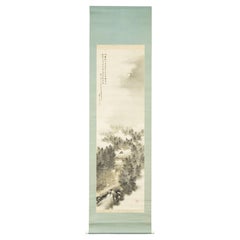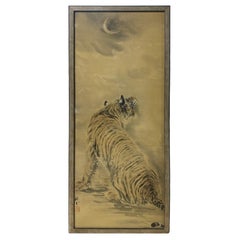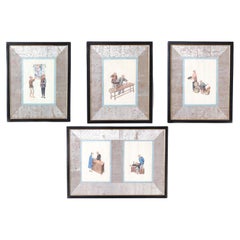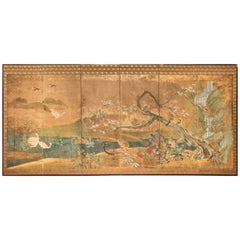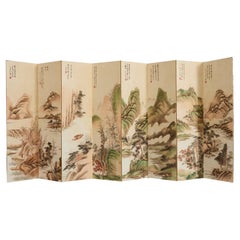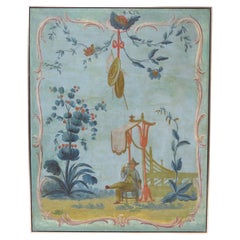Fabric Paintings and Screens
to
143
445
172
701
78
7
38
23
12
5
3
1
1
1
1
59
266
376
85
145
85
28
17
3
18
10
11
17
10
11
1
786
759
730
545
505
681
620
497
81
50
786
765
771
30
2
2
2
2
Material: Fabric
Japanese Meiji Period Painting Scroll Night Landscape Nihonga Japan Artist Sign
Located in Amsterdam, Noord Holland
Japanse school Boerderij in bamboebos in maanlicht
Rolschildering / scroll op zijde, benen rollers. B 140.4 x 42 / 198.5 x 54.5 cm
140.4 x 42 / 198.5 x 54.5 cm.
Category
Mid-19th Century Japanese Meiji Antique Fabric Paintings and Screens
Materials
Silk
Japanese Chinese Korean Asian Signed Framed Hand Painted Tiger Scroll Painting
Located in Studio City, CA
A beautiful and striking framed Asian tiger scroll painting featuring a regal tiger in the moonlight. This work is hand-painted with masterful brushstroke...
Category
Early 20th Century Japanese Showa Fabric Paintings and Screens
Materials
Silk, Wood, Paint
Set of Five Antique Chinese Watercolors on Silk
Located in Palm Beach, FL
Intriguing set of five Chinese watercolor paintings on silk depicting men occupied in their trades, executed in a soft delicate technique and presented under glass in four wood frame...
Category
Early 20th Century Chinese Chinese Export Fabric Paintings and Screens
Materials
Silver Leaf
Japanese Six-Panel Screen Waterfall and Cherry in Audubon Landscape
Located in Hudson, NY
Japanese six-panel screen: waterfall and cherry in Audubon landscape, Edo period painting, 18th century, depicting summer and spring. A Kano Schoo...
Category
Mid-18th Century Japanese Edo Antique Fabric Paintings and Screens
Materials
Gold Leaf
Chinese Eight Panel Folding Table Screen Landscapes Poems
Located in Rio Vista, CA
Fascinating Chinese Qing style 20th century eight panel folding table screen. The panels each features an idyllic landscape scene with a Chinese poem and artist seal. The reverse sid...
Category
20th Century Chinese Qing Fabric Paintings and Screens
Materials
Silk, Paper
Louis XV-Period Painted Canvas Chinoiserie Panel Framed
Located in Dallas, TX
large-scale, grand Louis XV painted canvas panel once set in boiserie, very fashionable exotic Chinoiserie decoration, great colors, beautiful scene, a seated man relaxing in the sha...
Category
Mid-18th Century French Louis XV Antique Fabric Paintings and Screens
Materials
Canvas, Paint
Magpie Nihonga Scene Meiji/Taisho Period Scroll Japan Artist Meiji Period
Located in Amsterdam, Noord Holland
Axis: Vertical 194 cm, horizontal 49.5 cm
Inside: Vertical 126 cm, horizontal 37 cm some errors will occur in the dimensions. Please understand.
Status I don't know the details of ...
Category
19th Century Japanese Meiji Antique Fabric Paintings and Screens
Materials
Silk
Rare Framed Chinese Woven Bamboo Jacket, Qing Dynasty
Located in Jimbaran, Bali
This bamboo vest from the Qing Dynasty required exceptional skill to craft, using extremely thin bamboo shoots and a thin silk lining on the edges. It was ...
Category
Late 19th Century Chinese Other Antique Fabric Paintings and Screens
Materials
Silk, Bamboo
ICHIMATSU by Blue Tip atelier
Located in Sammu-shi, Chiba
Title : ICHIMATSU
Japan / 2020s
Size : W 1480 x H 1480 mm
Each part is dyed with indigo to express a checkered pattern that collapses. This quilt is made with Woven fresh linen. Hand-quilted with cotton thread. Hand dyed with indigo.
[Blue Tip atelier...
Category
2010s Japanese Modern Fabric Paintings and Screens
Materials
Linen
sky color bird by Blue Tip Atelier
Located in Sammu-shi, Chiba
Title : sky color bird
Japan / 2024s
Size : w1620 x h1635 mm
Scraps of fabric used in the Sky series are used to express birds in the colours of the sky.
The materials used are li...
Category
2010s Japanese Modern Fabric Paintings and Screens
Materials
Linen
12' Foot Hand Painted Art Deco Damsel & Panther Oil on Canvas Screen
Located in Van Nuys, CA
Large 12' foot tall hand-painted artwork oil on a canvas featuring Art Deco Damsel & Panther fixed to a wood folding screen with a dark blue borde...
Category
1980s American Vintage Fabric Paintings and Screens
Materials
Canvas
Asian Two Panel Table Screen Flowering Prunus with Songbird
Located in Rio Vista, CA
Colorful Asian two panel byobu screen featuring a blossoming prunus tree with a songbird perched on its branch. Vibrant ink and color pigments applied to a golden silk ground. The pa...
Category
20th Century Chinese Chinese Export Fabric Paintings and Screens
Materials
Brass
Vintage kimono textile art "On Coral Waves ~Everlasting~" by ikasu Pink, Japan
By Kimono ikasu
Located in Setagaya City, JP
<< About this canvas >>
This kimono canvas set of three pieces portrays mountains surrounded by the sea. While each of the three pieces is crafted from different kimonos, they all s...
Category
1970s Japanese Japonisme Vintage Fabric Paintings and Screens
Materials
Silk, Canvas
Japanese Antiques 4th Head Torii Kiyotada Silk color scroll Momotaro Ukiyo-e
Located in Niiza, JP
Torii School 7th Head [4th Head Torii Kiyotada] Silk color scroll Japan No. 1 Momotaro Ukiyo-e
Silk color
Scroll head: Wood
box: Paulownia wood
Image size: 410 (W) x 1150 (H) [mm]
S...
Category
19th Century Japanese Antique Fabric Paintings and Screens
Materials
Silk, Paper
Actors in Dance / Theatre Scene 20th Century Scroll Painting Japan Artist
Located in Amsterdam, Noord Holland
It is a work of 2 scrolls figure in a Theatre/Dance Noh style.
it is a very tasty work combined with the hymns spelled at the top.
¦ Silk books and handwriting.
¦ State
There ...
Category
Early 20th Century Japanese Taisho Fabric Paintings and Screens
Materials
Silk
Pair of Two Panel Japanese Screens: Mountain Landscape with Waterfalls and River
Located in Hudson, NY
Rivers of mist, falling water and moss draped trees evolve into a mystical landscape. Ink on silk, bordered in fine mulberry paper. Sold as a pair.
Category
Late 19th Century Japanese Antique Fabric Paintings and Screens
Materials
Silk
Antique obi textile art " View from the Window ~ Shochikubai ~ " by ikasu, Japan
By Kimono ikasu
Located in Setagaya City, JP
This work is a glorious nod to buddhist temples circle windows, with beautiful Japanese garden scape seen outside. Golden leaf on the border of a frame is an expression of light goin...
Category
1910s Japanese Japonisme Vintage Fabric Paintings and Screens
Materials
Gold Leaf
Ronde by CHEN Yiching, Contemporary Four-Panel Nihonga Screen (Hand-Painted)
By Chen Yiching
Located in PARIS, FR
'Ronde' (Round) is a hinged four-panel screen covered with stretched paper on the front. The surface is hand-painted with mineral pigments and depicts a floral composition. Plants wi...
Category
2010s French Fabric Paintings and Screens
Materials
Paint, Paper, Wood, Fabric
Rare Triptych Scroll Paintings by Watanabe Seitei Meiji Period
Located in Atlanta, GA
A set of three paintings of ink and watercolor on silk mounted within brocade borders as scrolls by Watanabe Seitei (1851-1918). This is a very rare an...
Category
Early 1900s Japanese Japonisme Antique Fabric Paintings and Screens
Materials
Brocade, Silk, Wood
Lovely Nihonga Scene Meiji/Taisho Period Scroll Japan Artist Painting
Located in Amsterdam, Noord Holland
Lovely Nihonga scene Meiji/Taisho period scroll Japan artist painting. Painting size: (Width x height) mm 525 x 1499.
Category
19th Century Japanese Meiji Antique Fabric Paintings and Screens
Materials
Silk
Japanese Six Panel Screen: Deer in Moonlit Water Landscape
Located in Hudson, NY
Meiji period (1868 - 1912) painting of a family of deer exploring the grassy and rocky shoreline of a meandering creek under the moonlight. Shijo School ink painting with minimal pi...
Category
19th Century Japanese Antique Fabric Paintings and Screens
Materials
Brocade, Silk, Paper
Charles Sillem Lidderdale (1830-1895) RBA. Young Girl Portrait
Located in London, GB
Charles Sillem Lidderdale (British, 1831–1895).
There are 10 paintings by this artist in the British National Art Collection. Painting -
A good size measuring 70 cm x 60 cm Frame ...
Category
1880s British Victorian Antique Fabric Paintings and Screens
Materials
Canvas
Rare Japanese Floor Screen of Perched Eagles Soga Shohaku Edo period
Located in Atlanta, GA
A rare six-panel Japanese folding floor screen (Byōbu) by Soga Shōhaku (1730-1781) from Edo period. The screen depicts six perched hawk-eagles in various poses positioned in a litera...
Category
18th Century Japanese Edo Antique Fabric Paintings and Screens
Materials
Brocade, Wood, Paper
Sawtooth by Blue Tip Atelier
Located in Sammu-shi, Chiba
Sawtooth
?Japan / 2019s
Size : W 1640 x H 2050 mm
A tribute to the traditional American quilt design made around 1840. Made with organic cotton, and indigo cotton in Alsace region ‘France. Hand dyed with chinese sumac and green leaf on the surface, and pomegranate on the back.
[Blue Tip atelier...
Category
2010s Asian Modern Fabric Paintings and Screens
Materials
Linen
Lovely Nihonga Scene Meiji/Taisho Period Scroll Japan Artist Landscape Miyahara
Located in Amsterdam, Noord Holland
It is a work drawn by Miyahara Yanagi as you can see.
It is a pine tree drawing of Karasaki that has a unique presence, and it is
very attractive as it goes well with smoke.
¦ S...
Category
19th Century Japanese Meiji Antique Fabric Paintings and Screens
Materials
Silk
Frank Kyle Extraordinary 3-Panel Screen with Japanese Motif, 1950s
By Frank Kyle
Located in New York, NY
Extraordinary three-panel screen in walnut and bronze by Frank Kyle, Mexico, 1950s. One side of the screen features a pastoral scene with Japanese figures...
Category
1950s Mexican Mid-Century Modern Vintage Fabric Paintings and Screens
Materials
Bronze
Large Framed Japanese Buddhist Amida Temple Hall Painting, Mid-19th Century
Located in Austin, TX
A large and incredible Japanese painting of a Buddhist temple hall with Amida Nyorai, late Edo or early Meiji period, mid-19th century, Japan. Mounted wit...
Category
Mid-19th Century Japanese Meiji Antique Fabric Paintings and Screens
Materials
Brocade, Silk, Acrylic, Wood, Paint
Taisho Period Painted Silk Screen Depicting Nesting Cormorants by Asami Joujou
Located in Stamford, CT
An exquisite Taisho period screen depicting nesting cormorants painted on raw silk with gold fleck by Japanese artist Asami Joujou (b. 1890 in Himeiji, Japan-d. 1974), circa 1912-1926.
Category
1920s Japanese Taisho Vintage Fabric Paintings and Screens
Materials
Silk
Japanese Two Panel Screen: Flowers by River's Edge
Located in Hudson, NY
Mineral pigments on gilded silk with gilded bronze hardware. Signature reads: Shunkan.
Category
1930s Japanese Vintage Fabric Paintings and Screens
Materials
Bronze
A Very Good Tibetan Thangka Depicting Buddha Nagaraja, 19th Century or Earlier
Located in Ottawa, Ontario
A striking 19th century Tibetan thangka of the enlightened one, Buddha Nagaraja; King of Nagas (a.k.a. Buddha Nageshvara). Shown seated in the vajra position atop a lotus blossom, ha...
Category
19th Century Tibetan Tibetan Antique Fabric Paintings and Screens
Materials
Other
Japanese Two Panel Screen: Ikebana 'Flower Arrangement'
Located in Hudson, NY
Mineral pigment on gold silk. Signature reads: Nana Keicho Ho, Shinsho, Gachu ; Seal reads: Soju ; Seal on reverse reads: Koto Fusai.
Category
Late 19th Century Japanese Antique Fabric Paintings and Screens
Materials
Silk
Japanese Two-Panel Screen Peony and Cherry
Located in Hudson, NY
Japanese two-panel screen: Peony and Cherry, Edo period (circa 1800) painting, formerly fusuma (Japanese sliding doors), executed in the Kano school style, featuring a cherry tree in...
Category
Early 1800s Japanese Edo Antique Fabric Paintings and Screens
Materials
Gold Leaf
Japanese Six Panel Screen: Red Maple and Flowers on Gold Silk
Located in Hudson, NY
Rimpa Floral Scene with Chrysanthemum, Morning Glories and Blue Bell Flowers. Pigment on gilded silk, signature and seal read: Hattori Shunyo. Bold colors and strong design elements combined with the trademark tarashikomi (diluted elements created when water is applied to the surface before or after pigments causing them to diffuse) exhibit the artists deep devotion to this important Japanese painting tradition. Notes about artist: Hattori Shunyo (b. 1883) was an artist from Kyoto who graduated the (now) Kyoto Municipal University of Art and fell under the circle of Yamamoto Shunkyo...
Category
Early 20th Century Japanese Fabric Paintings and Screens
Materials
Brocade, Silk
Italian Neo-Classical Style Landscape Painting 6-Paneled Folding Screen
Located in Queens, NY
Antique Italian Neo-Classical-style six-paneled canvas folding screen connected with brass hinges and painted with a vignette of figures at a river's edge surrounded by a painted, or...
Category
20th Century Neoclassical Fabric Paintings and Screens
Materials
Canvas, Acrylic, Wood
Japanese Edo Two Panel Screen Children Playing Catching Fish
Located in Rio Vista, CA
Delightful late 18th century/early 19th century Japanese Edo period two panel byobu screen depicting children at play near a riverbank and catching fish. Painted in the Maruyama-Shij...
Category
18th Century Japanese Edo Antique Fabric Paintings and Screens
Materials
Silk, Wood, Paper
Antique kimono textile art " Kobachi ~Marine Collection~ " by ikasu Blue, Japan
By Kimono ikasu
Located in Setagaya City, JP
This work is inspired by the blue color palette, and is framed in paulownia wood originally used for a kimono chest-of-drawers.
In this artwork, the aim was to capture the wide pale...
Category
1920s Japanese Japonisme Vintage Fabric Paintings and Screens
Materials
Silk, Wood
Vintage kimono textile art "Snowflake ~New Beginnings~" by ikasu Purple, Japan
By Kimono ikasu
Located in Setagaya City, JP
Six canvases (Diameter approx. 30cm, 25cm, 20cm) use the fabric taken from antique kimono, its' various parts, to create one harmonious fluid image of a snowflake - a symbol of new b...
Category
1970s Japanese Japonisme Vintage Fabric Paintings and Screens
Materials
Canvas, Silk
Japanese Two-Panel Screen, Hibiscus In Bloom
Located in Hudson, NY
Japanese Two Panel Screen: Hibiscus in Bloom, Meiji period (1868 - 1912) painting of hibiscus flowers reaching for the sun in full bloom. Mineral pigments on silk with a silk brocad...
Category
Early 1900s Japanese Meiji Antique Fabric Paintings and Screens
Materials
Silk, Wood, Paper
Bali Hindu Textile Framed 'Kamasan' Painting, Indonesia C. 1950
Located in Jimbaran, Bali
This striking vintage Balinese Kamasan painting, rendered on handwoven cotton, beautifully captures the timeless elegance of classical Wayang-style st...
Category
1950s Balinese Folk Art Vintage Fabric Paintings and Screens
Materials
Cotton, Paint
Japanese Six Panel Screen: Snow Scene
Located in Hudson, NY
Kano school painting of a pheasant in a snowy pine. Artist signature reads: Hokkyo Shunyo. Mineral pigments on gold leaf with silk brocade border.
Category
Early 19th Century Japanese Antique Fabric Paintings and Screens
Materials
Gold Leaf
Lovely Nihonga Scene Meiji/Taisho Period Scroll Japan Artist Reika Yoshikawa
Located in Amsterdam, Noord Holland
Reika Yoshikawa (Reika Yoshikawa, Meiji eight years (1875) May 4 days-Showa 4 years (1929) March 25), the Meiji Taisho era Japan painter. His real name is Hitoshi, commonly known as Saburo.
Yamato-e basic widely while the oriental of classical learning in art, line drawing, especially in Seiga paintings representation by taking advantage of beautiful thin line, such as flow, "draw" from "null" to the center of gravity is going modern...
Category
19th Century Japanese Meiji Antique Fabric Paintings and Screens
Materials
Silk
Kawai Gyokudō Nihonga Scene Early 20th Century Scroll Painting Japan Artist
Located in Amsterdam, Noord Holland
It is a high-quality craft of the work drawn by Kawai Gyokudo as you can see.
It creates a texture that makes you feel a refreshing breeze, and it is
a tasty work that is carefully drawn even to lush bushes and trees.
(A guidebook (bookmark) is also included.)
"Kawaai Gyokudo"
[1873-1957] Japanese painter. Born in Aichi.
His real name is Hosaburo. Another issue, Ikuan.
At the beginning, he studied under the Shijo school and then Masakuni Hashimoto to study the Kano school, and established
his own style as a moderate landscape painting full of poetry.
Received the Order of Culture. Work "Ayaame" etc.
¦ Paper books and crafts.
¦ The condition is
beautiful.
¦ Axial dimension/approx. 128.0 cm x 62.0 cm.
¦ Paper size/approx. 40.5 cm x 51.0 cm.
¦ Incorporation/There are inscriptions/incorporations as you see.
¦ Box/Box.
awai Gyokudo (?? ??, November 24, 1873 – June 30, 1957) was the pseudonym of a Japanese painter in the nihonga school, active from Meiji through Showa period Japan. His real name was Kawai Yoshisaburo.
Contents
Biography
Gyokudo was born in what is now Ichinomiya city, Aichi Prefecture, as the eldest son of a paper, ink and brush merchant. He went to Kyoto in 1887 to study under Kono Bairei of the Maruyama-Shijo school of painting. In 1896, he moved to Tokyo and he became the student of Hashimoto Gaho, of the Kano school. He also studied Western-style painting and developed a highly personal style, especially in the field of landscape painting.
Gyokudo is noted for his polychrome and occasionally monochrome works depicting the mountains and rivers of Japan in the four seasons, with humans and animals shown as part of the natural landscape. Among his representative works are Futsuka zuki (“The New Moon”), Yuku haru (“The Departing Spring”), Mine-no-yu (“Evening at the Mountain Top”), and Bosetsu (“Snow in the Evening”).
In 1898, Gyokudo joined with Okakura Tenshin and Yokoyama Taikan...
Category
Early 20th Century Japanese Taisho Fabric Paintings and Screens
Materials
Silk
Japanese Silk Scroll by Haruki Nanmei Edo Period
Located in Atlanta, GA
A Japanese hanging silk scroll by late Edo period painter Haruki Nanmei (1795-1878). The gouache painting was in the tradition of Kano school and depicts an old scholar dressed in lo...
Category
19th Century Japanese Edo Antique Fabric Paintings and Screens
Materials
Silk, Paper
Thai Temple Scroll Painting
Located in Miami, FL
Offered is a "Phrabot" - an antique Thai Temple scroll painting depicting village life around the temple. The painting is attributed to the "Rattanakosin S...
Category
Late 19th Century Thai Antique Fabric Paintings and Screens
Materials
Canvas, Paint
Vintage kimono textile art "Marble Story ~ Healing ~" by ikasu Grey, Japan
By Kimono ikasu
Located in Setagaya City, JP
This work uses a vintage kimono fabric with marble pattern, that makes it look like a real piece of marble.
The line in the middle symbolizes “kintsugi” - concept of wabi-sabi, which values imperfection, impermanence, and the beauty of aging.
It is elegantly framed with paulownia wood originally used for kimono chest-of-drawers, and is filled with storytelling and sense of luxury.
I used pieces of kimono that could no longer be used as clothing and kiritansu chest-of-drawers that would normally be discarded to create the ultimate upcycled piece.
<< Explanation and meaning of pattern and colors >>
Kintsugi (金継ぎ), which translates to "golden joinery" or "golden repair," is a traditional Japanese art form of repairing broken pottery with lacquer mixed with powdered gold, silver, or platinum. I used this tecnique here to "repair" antique kimono by transforming it into art work. Beyond its literal meaning of mending broken ceramics, kintsugi carries profound philosophical and cultural significance in Japanese tradition:
・Embracing Imperfection: Kintsugi celebrates imperfection and impermanence. Rather than disguising or concealing flaws, it highlights them, treating the breakage as part of the object's history. This philosophy encourages acceptance of imperfection as an essential aspect of life, beauty, and human experience.
・Wabi-Sabi Aesthetic: Kintsugi embodies the principles of wabi-sabi, an aesthetic worldview centered on the acceptance of transience and imperfection. Wabi-sabi values simplicity, authenticity, and the beauty of things that are imperfect, impermanent, and incomplete. Kintsugi exemplifies these principles by turning what might be considered flaws into features that enhance the object's beauty and character.
・Resilience and Transformation: The act of repairing broken things with precious metals symbolizes resilience and transformation. Instead of discarding or replacing the broken object, kintsugi honors its history and transforms it into something new and valuable. This reflects broader philosophical themes of overcoming adversity, finding beauty in imperfection, and embracing change.
・Honoring the Past: Kintsugi preserves and honors the history of the object. Rather than erasing or ignoring its past, it acknowledges and celebrates it. This aspect of kintsugi can be seen as a metaphor for honoring our own personal histories, including the challenges and setbacks we have faced, and recognizing how they have shaped us into who we are today.
・Spiritual and Philosophical Symbolism: Kintsugi has spiritual and philosophical implications, reflecting concepts such as the interconnectedness of all things, the cycle of life and death, and the pursuit of harmony and balance. The process of repairing broken objects with precious metals is seen as a metaphor for spiritual growth, enlightenment, and the journey towards wholeness.
Overall, kintsugi represents not only a practical technique for repairing ceramics but also a profound philosophical and cultural perspective on life, beauty, and the human experience. It embodies values such as resilience, acceptance, and the transformative power of embracing imperfection.
<< Characteristics of the fabric >>
This vintage textile is hand-painted with a traditional painting technique where the colors are added on wet surface, which creates an effect of marble.
<< About the frame >>
Kiritansu - chest-of-drawers for kimono, is traditionally made from paulownia wood, a uniquely Japanese material closely tied to the world of kimonos.
Paulownia wood is known as the lightest wood in Japan, prased for its natural luster, resistance to moisture, and resilience against cracking. Since ancient times, it has been used in crafting furniture, chests, and musical instruments.
During the Edo period, it became customary to store cherished kimonos in paulownia chests...
Category
1960s Japanese Japonisme Vintage Fabric Paintings and Screens
Materials
Gold Leaf
Immortal He Xiangu Painting on Canvas, China, 19th Century Asian Art
Located in Beuzevillette, FR
Chinese painting depicting He Xiangu reproduced three times but with a different attribute: up a lotus flower, bottom left a fly hunt and bottom right again the lotus flower, each time surrounded by disciple the one praying right, the one on the left seems to bring him a bowl.
Pigments on linen or hemp,
19th century.
He Xiangu or Ho Hsien-ku, "Immortal Demoiselle He," is an immortal Taoist, a member of the group of Eight Immortals. She is represented holding in her hand a lotus symbolizing spiritual fulfillment, and sometimes also a sheng, a peach of immortality, a wooden ladle...
Category
19th Century Chinese Qing Antique Fabric Paintings and Screens
Materials
Canvas
Painted canvas representing flowers and birds. Contemporary work.
Located in Saint-Ouen, FR
Painted canvas, or decorative panel representing flowers and birds, rectangular in shape.
Contemporary French work.
Dimensions: H x W cm
Reference: LS60201200?A
Raw linen canvas ...
Category
20th Century French Fabric Paintings and Screens
Materials
Copper, Gold Leaf
Lovely Scroll Painting Japan, 20th Century 'Showa' Artist Flower
Located in Amsterdam, Noord Holland
Overall perfect: Size scroll... 142.0cm × about 55.0cm. Painting about 40.0cm × about 41.5cm.
30-12-18-1-11 (65)
Condition
Overall Perfect: Size scroll... 142.0cm × about 55.0cm...
Category
20th Century Japanese Showa Fabric Paintings and Screens
Materials
Fabric
Early 20th century (Meiji period) crane scroll. Original storing box
Located in Fukuoka, JP
This Meji -Taisho period painting captures a serene moment in nature, depicting graceful bird resting. Painted on silk . Signed. Includes original storage box
Size: Overall 138/...
Category
Early 20th Century Japanese Meiji Fabric Paintings and Screens
Materials
Silk, Paper
Korean Hanging Scroll of Bamboo, Prunus and Orchids
Located in Chicago, IL
This exquisite hanging scroll painting from the late 18th century depicts the sacred form of the bodhisattva Guanyin, known in Japanese Buddhism as Shō Kannon, or Guze Kannon. Descri...
Category
Mid-20th Century Korean Fabric Paintings and Screens
Materials
Silk, Paper
Japanese Two Panel Screen: Trees in Floral Landscape
Located in Hudson, NY
Japanese Two Panel Screen: Trees in Floral Landscape, Edo period painting (mid 19th century) of pine and other trees amongst flowers, with bamboo shoots on the right panel, and white...
Category
Mid-19th Century Japanese Antique Fabric Paintings and Screens
Materials
Gold Leaf
Japanese Meiji Period Painting Scroll Crane Landscape Nihonga Japan Artist Sign
Located in Amsterdam, Noord Holland
Japanse school Kraanvogels en schildpadden in stromend water met Horaisan op de achtergrond
Rolschildering / scroll op papier, houten rollers. B 100.5 x 26.7 / 183.5 x 37.7 cm
100....
Category
Mid-19th Century Japanese Meiji Antique Fabric Paintings and Screens
Materials
Silk
Japanese Six Panel Screen: Waka Poems on Basketry Design
Located in Hudson, NY
Ribbons of 17th century calligraphy poems are mounted on an 18th century screen with a woven bamboo motif. These poems are aristocratic Waka poem...
Category
17th Century Antique Fabric Paintings and Screens
Materials
Gold, Bronze, Gold Leaf
Autumn Scene Meiji Period Scroll Japan 19c Artist Marked Nihonga Style
Located in Amsterdam, Noord Holland
As you can see, Japanese painting late autumn Akino map / with box.
It is
a beautiful work that depicts the melancholy scenery of Akino, which is unique to late autumn , and is com...
Category
Mid-19th Century Japanese Meiji Antique Fabric Paintings and Screens
Materials
Silk
Meiji Chrysanthemum Masterpiece
Located in Fukuoka, JP
Step into a world of timeless beauty with our exceptional six-panel screen from the Edo-Meiji period. In impeccable condition, each panel features stunning paintings of chrysanthemum...
Category
19th Century Japanese Meiji Antique Fabric Paintings and Screens
Materials
Gold
Italian Neoclassical Bird and Garden Vignette Folding Screen
Located in Queens, NY
Italian neoclassical-style four panel folding screen hand-painted with an array of birds in a garden on the front and brown detailing on the reverse.
Category
20th Century Neoclassical Fabric Paintings and Screens
Materials
Canvas, Wood
Japanese Six Panel Screen: Rimpa School Painting of Winter to Spring
Located in Hudson, NY
With exotic birds including a family of quail. Mineral pigments on mulberry paper with gold dust and a silk brocade border.
Category
Early 19th Century Japanese Antique Fabric Paintings and Screens
Materials
Gold Leaf
Artists Kawai Gyokudō Showa Period Scroll Japan 20c Artist Nihonga
Located in Amsterdam, Noord Holland
Kawai Gyokudo (?? ??, November 24, 1873-June 30, 1957) was the pseudonym of a Japanese painter in the Nihongo school, active from Meiji through Showa period Japan. His real name was Kawai Yoshisaburo.
Contents
Biography
Gyokudo was born in what is now Ichinomiya city, Aichi Prefecture, as the eldest son of a paper, ink and brush merchant. He went to Kyoto in 1887 to study under Kono Bairei of the Maruyama-Shijo school of painting. In 1896, he moved to Tokyo and he became the student of Hashimoto Gaho, of the Kano school. He also studied Western-style painting and developed a highly personal style, especially in the field of landscape painting.
Gyokudo is noted for his polychrome and occasionally monochrome works depicting the mountains and rivers of Japan in the four seasons, with humans and animals shown as part of the natural landscape. Among his representative works are Futsuka zuki (“The New Moon”), Yuku haru (“The Departing Spring”), Mine-no-yu (“Evening at the Mountain Top”), and Bosetsu (“Snow in the Evening”).
In 1898, Gyokudo joined with Okakura Tenshin and Yokoyama Taikan...
Category
20th Century Japanese Taisho Fabric Paintings and Screens
Materials
Silk
